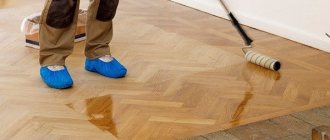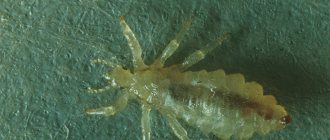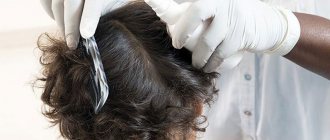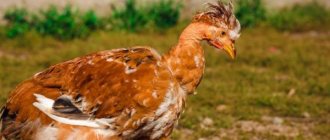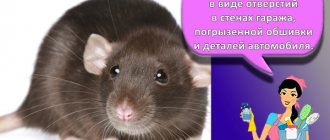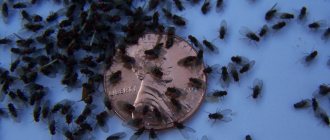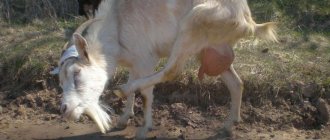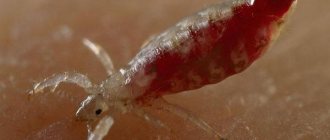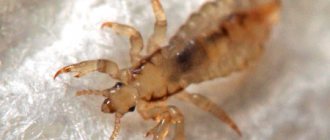What do linen lice look like: YouTube/Disinfection Center Linen lice are dangerous parasites whose bites pose a potential threat to human health. Small creatures feed on human blood and live in bedding, mattresses, pillows and blankets. What lice look like, where they come from and what to do if you have a bed louse - information that will help the housewife fight parasites.
Features of linen lice
Unlike head and pubic parasites, linen lice do not stay on the human body for long. They live in bedding, underwear, beds, and mattresses. These parasites prefer stale, stale natural fabrics such as linen and cotton with the smell of perfume. The eggs are attached to the tissue using a special sticky liquid and are actually “hatched” by a person using body temperature. These lice are not able to stay on hair; they crawl onto the skin only looking for food.
Life cycle
A nit is a capsule, an egg in which an insect larva develops. Its dimensions are no more than 1.5 mm; it can be difficult to discern nits; their accumulation looks like sand. The egg is translucent, attached to the surface with the help of a sticky secretion secreted by the female. Within 7–10 days, a larva, a nymph, emerges from the nit. In 7–10 days, it goes through several molts and becomes an adult, ready for reproduction. Females live up to 45 days, males - up to 30 days. An adult female lays 4 – 5 eggs per day.
What does a linen louse look like?
A person who has noticed numerous insect bites on their body needs to know what bed lice look like. A victim who has been attacked by parasites for the first time may confuse blood-sucking bugs with bedbugs, and therefore choose the wrong method of control.
The insect's body size does not exceed 3 mm. It has the shape of an oval, pointed at the bottom. The abdomen of a hungry louse is usually white; it turns red and swells in a well-fed individual. An adult insect has 6 legs with tenacious claws located in the upper part of the body.
Where can you get infected?
Today, it is no longer believed that untidy people are more likely to “catch” lice, and cases of infection of children in kindergartens are also quite common. It is known that anyone who is inevitably doomed to have close contact with strangers or other people's things is at risk. In other words, in such situations you need to be alert. Places where you are most likely to become infected with lice:
- public transport (as a result of forced close contact with possible infected people, when the parasite can easily crawl from one carrier to another);
- trains (in the case of using previously contaminated bed linen that has not undergone sufficiently high-quality treatment);
- hiking, sleeping in tents side by side (probably close proximity to people infected with linen lice);
- homeless dens, which are breeding grounds for various infections;
- cheap hotels, hostels, where the treatment of bed linen is clearly not up to par;
- while spending the night in someone else's house, where there are lice;
- after purchasing clothes that were used by infected previous owners.
If for some reason it was not possible to avoid visiting the listed places, the clothing should then be carefully examined (especially folds and seams) for infestation with linen lice.
Ways to get rid of parasites
First of all, affected residents are interested in how to get rid of bed lice. Over the years, many ways have been found to combat these blood-sucking creatures. Some are distinguished by their simplicity, others by their effectiveness, and others by their safety for humans. Let's take a closer look at how you can deal with these insects.
Folk remedies at home
How to get rid of linen lice at home is of interest to many. Traditional methods are accessible and inexpensive; they can be used if professional insecticides are not at hand or a person is allergic to them.
You can destroy lice by the following means:
- concentrated decoction of tansy. It is prepared from the branches and flowers of the plant, then cooled. The broth is used to wash the floor and is added when washing underwear and bed linen. Dry branches of the plant can be placed in wardrobes and drawers with linen.
- A 2% suspension of pyrethrum (chamomile) and dust. All surfaces in the house are treated with the product; after 3 hours, wet cleaning is carried out. It is worth considering that the dust is toxic to pets, so it is better to remove all pets from the treatment area.
- Turpentine or kerosene. It is recommended to rub the product on the body of an infected person. A sharp, specific smell will scare away the parasite, but will not destroy it.
- Vinegar. As with head lice, this product damages the adhesive substance that attaches the nits, preventing reproduction.
- Essential oils. Of course, they will not destroy an insect like a louse. However, if you rub the skin with a product with a strong aroma, you can scare away the bloodsucker.
- A decoction of milkweed. It is added when rinsing clothes, dried flowers are placed next to things, inside cabinets.
- Cranberry juice. The product is able to remove lice and nits, since it contains an acid that dissolves the shell of insects. In addition, when applied to the skin, the juice relieves itching after bites.
In addition to the listed herbs, many plants are capable of defeating insects such as lice, for example, bird cherry, mint, celandine, and wormwood. They make decoctions that are used to treat things.
Boiling bedding and clothing
This is a simple, effective remedy for body lice. Parasites of this kind actively reproduce at temperatures of 310C; extremely high and extremely low temperatures are fatal for them. The louse dies already at 400C, so to effectively treat the bedding, it is enough to boil it or wash it with hot water.
Unfortunately, not all fabrics tolerate washing at high temperatures equally well, so it is better to iron things to be safe.
Body treatment
What to do if there are bed lice in the house, how to get rid of them and clean things?
These questions are of primary interest to residents. Not everyone knows that single lice, as well as their larvae, can linger on the human body, causing re-infection.
To prevent such a situation, the victim should treat the scalp and body with special shampoos that are effective against lice. Hair preparations such as Medifox, Veda, Bubil, Lauri, etc. are suitable. Pharmacy insecticides are sold without a prescription and are relatively inexpensive.
Tar soap, which can be used even by children, is highly effective in destroying a parasite such as a louse. You should wash in the shower in the hottest water possible.
Cleaning clothes
This stage is no less important than processing bed linen. You can use a folk remedy, for example, turpentine, but the unpleasant smell, stains, stains that remain after the preparations can spoil the item so much that you have to throw it away.
Of course, you can simply put things on the balcony or outside - the insects, without receiving food, will die of hunger within a week. However, this is not the most reliable remedy for linen lice. It will be much more effective to wash clothes, boil them, treat them with an insecticide, or leave them in the cold, for example, putting them in the freezer for a week.
Apartment disinfection
Even though lice do not live far from the human body, treating the entire room will reduce the likelihood of new insects appearing. They are destroyed in the same way as most arthropods - with the help of insecticides. Before fighting linen lice, you need to prepare an emulsion (2% dust solution). The resulting product is applied to all accessible surfaces, paying special attention to wardrobes, and then washed off after 2-3 hours.
Carpets, rugs, upholstered furniture, as well as other things on which stains may remain after using an insecticide should be treated with a steam generator and, if possible, taken to dry cleaning.
Folk methods of struggle
Some plants contain components that have an insecticidal and repellent effect. For prevention, dried or fresh herbs are taken and laid out in bunches in cabinets. For destruction, strong decoctions, extracts, and extracts added during washing are used.
Linen lice can be killed using various herbs.
Active substances that are harmful to linen lice are:
- wormwood;
- field milkweed;
- tansy;
- larkspur;
- hellebores.
Linen louse cannot tolerate the aroma of lavender and tea tree, so the essential oils of these plants are added to the water for washing contaminated items.
In the past, kerosene and soda ash solution were used to soak laundry. These products have a detrimental effect on lice, but today they are not used due to their health hazards.
Signs of appearance
Unfortunately, most people do not know how to recognize the appearance of lice in clothes at the initial stage. Their bites are often confused with the bites of other insects, such as mosquitoes. Only when multiple marks appear on the body do parasites become suspected.
Characteristic signs of a lice attack:
- bites. These insects do not have a proboscis, so they bury their heads deep under the skin. Because of this, the affected area is quite large. The bites are located chaotically; they do not have the “paths” characteristic of bedbugs.
- Severe itching. The affected areas have to be constantly combed, which can lead to the appearance of pustules, boils, and ulcers.
- Restless sleep. During night lice attacks, a person sleeps restlessly, itches, and tosses and turns, which leads to chronic fatigue.
- Presence of insects on the bed. They can be detected by examining linen, pillows, and blankets.
The presence of at least one of the symptoms listed is a reason to be wary and carry out a systematic inspection of your home.
How dangerous are lice?
In addition to bites and inflammation, parasites are sources of dangerous infectious diseases that are difficult to tolerate and fatal. They enter the body through bites and remaining wounds on the body.
Main emerging diseases:
- Typhus - appears directly from body lice bites. Bacteria, when scratching the affected area, penetrate into the blood. Its symptoms are fever, specific rashes, headache.
- Relapsing fever is a severe acute disease transmitted by parasites. Symptoms are similar to typhus, but with the addition of delirium, enlarged liver and spleen.
- Trench fever is an infectious disease characterized by a rash and muscle pain. Infection occurs through the feces of infected insects into wounds.
- Sepsis - occurs from the penetration of bacteria into wounds after bites during scratching and unsanitary conditions. Accompanied by suppuration of the skin, ulcers, fever, chills, and blood poisoning.
- Pediculosis is a parasitic disease accompanied by severe itching, skin damage, and the formation of boils when the infection gets deep into the skin.
- Tularemia is a focal infection that affects the lymph nodes, skin and lungs. It occurs with symptoms of intoxication, fever, the appearance of festering buboes, ulcers and rashes. Its causative agent is the tularemia bacillus, which is carried by the bed louse.
- Allergy - occurs as a result of the introduction of a substance released when a louse bites. Characterized by redness, itching, inflammation.
Answers to popular questions
Most often, victims ask the following questions:
- How long do bed lice live? About 40 days with a constant food source. If there is none, then parasites such as lice die after 3–4 days.
- What causes them to start? It is a mistake to believe that these bloodsuckers appear where hygiene rules are neglected. They are easy to bring from public events or from a store, trying on someone else's clothes.
- What does a body louse larva look like? The oval, whitish nits are about 0.5 cm long and are barely visible on clothing. The larvae that hatch are identical to the adults, they differ from them only in size.
We will look at some questions in a little more detail.
What is the danger to humans?
Linen lice bites cause a lot of unpleasant moments for the victims. They itch, itch, causing anxiety around the clock. Lice can carry serious diseases such as typhus. Body lice can cause allergies. In this case, a person experiences symptoms such as: nausea, swelling, fever, headaches.
Where do they come from?
People who know nothing about lice think that they grow in dirty, neglected rooms. In fact, they are easy to bring with things from the store, especially second-hand ones. Lice cannot jump like fleas, but they can crawl long distances.
Probable methods of infection:
- buying and trying on things from the store;
- visiting places with unsanitary conditions (children's camps, old houses, dysfunctional families);
- travel by public transport.
Without finding a donor, the adult dies within a few days; the nit can remain viable for several months.
Where do linen lice live?
Most often these creatures are found in bed. Therefore, processing linen is the main method of combating bloodsuckers. They can also fill sofas, but only if someone regularly sleeps on it.
Another common place for lice to live is underwear. The closer an arthropod is to the human body, the more comfortable it feels.
The main location of lice is in folds, seams, and joints.
What do they eat?
The main food source for lice is human blood. An adult needs to eat at least 3 times a day to maintain life. Lice usually live in clothing; they make forays onto the skin only to feed. Larvae (small insects that have not reached maturity) that hatch from nits feed on the same thing as adult lice - blood.
How do linen lice reproduce?
Once they reach maturity, bed lice begin to multiply. Each female is capable of laying 3–10 eggs daily for the rest of her life (about 1–1.5 months). From the moment the larva emerges from the nit until the age of puberty, 3 molts pass, approximately half a month. Thus, the number of lice increases exponentially every 2 weeks under favorable temperature conditions and plentiful food.
The life cycle of lice can be represented in a certain sequence:
- nit (a capsule that contains parasite eggs). Does not require food and can remain viable for several months.
- Nymph (larva before first molt). It feeds on blood and sheds its shell within a day.
- Louse. It needs regular feeding, the second moult takes place after 5 days, the third – after another 8, after which the individual turns into an adult insect capable of reproduction.
Favorable temperatures, as well as the presence of a constant source of food, can accelerate the growth of lice. Cold, on the contrary, will delay the development of individuals.
Once the lice have been removed, it is worth considering how to prevent their further occurrence. This can be done using such simple methods as: maintaining personal hygiene, washing, ironing things. Preventive methods are not a 100% guarantee, but the likelihood of lice appearing will be reduced.
Preventive measures
The main measure to prevent the appearance of bed lice is keeping your clothes, sleeping area and entire home clean.
The following recommendations will help reduce the risk of parasite infection:
- When traveling, wear clothes with smooth synthetic or silk fibers.
- If you are forced to stay in unsanitary conditions, use prophylactic products based on essential oils.
- Wash pillows, blankets, blankets or take them to the dry cleaner.
- Keep bed linen dry and fresh; damp linen should be washed again and dried well.
- Carpets, especially natural ones, as well as upholstered furniture, should be regularly vacuumed and treated with insecticidal compounds.
- Observe personal hygiene rules and do not use other people's things.
Always wash newly purchased clothes, no matter where they were purchased - at a garage sale, second-hand store or boutique.
Prevention
Protecting yourself from lice infection is actually not that difficult:
- avoid contact with unkempt people (especially strangers);
- do not stay overnight in dubious places;
- do not purchase upholstered furniture or used clothing from strangers;
- do not invite people into the house who are not clean;
- regularly inspect clothing (especially for children);
- do not try to save money on cheap accommodations while traveling;
- store your clothes separately from others in common areas (baths, swimming pools, fitting rooms, etc.);
- change clothes more often (without a breadwinner, a bed louse dies within a few days).
These are just simple preventive measures, which, if taken with due seriousness, can protect yourself from bed lice infection.
Living conditions
A louse lives 30–40 days. To live and reproduce, it needs to have access to a food source. The parasite feeds up to 6 times a day.
The decisive factor determining life expectancy is air temperature. The most comfortable temperature is 31 degrees. It is under these conditions that all types of lice live and reproduce. When it drops to 20 degrees, the louse stops reproducing; when it gets colder, it goes into suspended animation and dies after a couple of days. High temperatures of more than 40 degrees are also detrimental to the parasite.
Lice can survive in high humidity. They are not even afraid of water and can stay in it without risking their lives for some time. Drought is more destructive for them.
Danger and possible consequences of infection
Body lice are dangerous due to the following consequences:
- Night sleep disorder.
- Decreased concentration.
- Anxiety.
- Violation of the integrity of the skin and the appearance of purulent wounds on them.
- Skin roughening - the insect injects a substance under the skin that reduces blood clotting. If the bite occurs several times in the same place, excessive accumulation of melanin occurs. The area of skin becomes rougher, changes color, and begins to peel off.
- Allergy to saliva and other insect waste products.
- Folliculitis, eczema - the result of scratching bites.
Lice are carriers of Volyn fever, tularemia, and typhus . Of course, nowadays these diseases are very rare, but they still should not be excluded.
Important! Diseases such as AIDS and viral hepatitis cannot be tolerated by lice.
